M.S.
Johan van Oldenbarnevelt, became the T.S.M.S. Lakonia in 1963
Please Note: Firefox & some other
search engines may not suitable
Please use Google Chrome for this page to
load perfectly!

Click the
logo above to reach the ssMaritime FrontPage & the current
Featured Ships
With
Reuben Goossens
Maritime
Historian, Author, Cruise‘n’Ship Reviewer and Maritime
Lecturer
Please Note: All ssMaritime and related
maritime sites are 100% non-commercial and privately owned, thus
ssmaritime is NOT associated with any shipping company or any
other organisation! Although the author has worked and been
involved in the passenger shipping industry for well over 60
years, but due to his old age and poor health, he was forced to
retire. Yet, he has completed well over 1,365 Classic Liners,
Passenger-Cargo Liners as well as humble converted C3 converted
Migrant Liners, which has transported countless thousands of folk
to the new world, as well on vacations’. I trust the
features online will continue to provide Classic Liner and Ship
enthusiasts both the information they are seeking, but more so
provide a great deal of pleasure and relive many happy memories!
“Memories
of the JVO”
MS
Johan van Oldenbarnevelt
Chapter Three
1946
to 1959
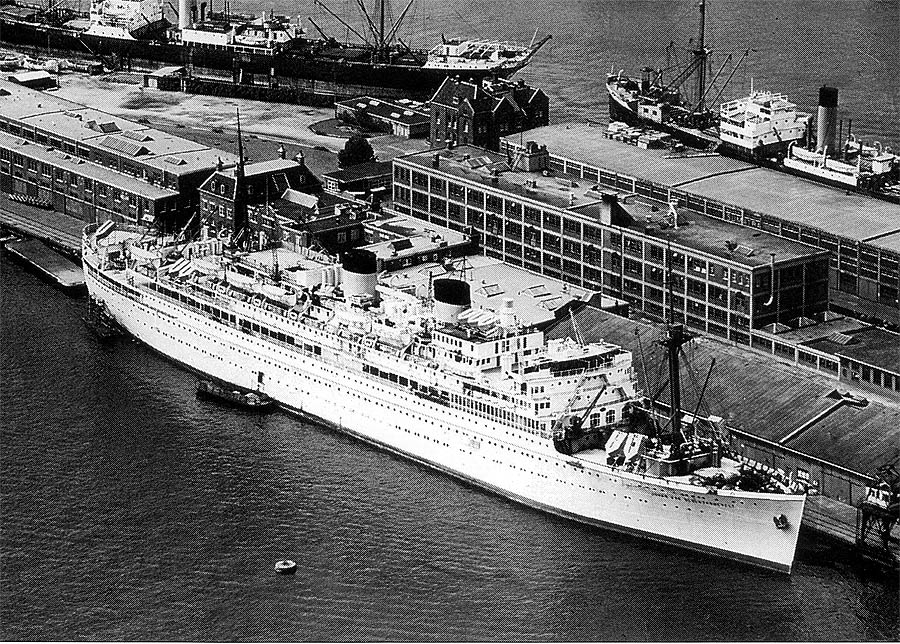
The Johan
van Oldenbarnevelt seen in Amsterdam in May 1948
The m.s. Johan van Oldenbarnevelt having
returned home in February 13, 1946 from being a full scale troop
ship. The question begs, was it true that her days as a troop
ship had in fact concluded now she had returned home? The sad
fact was that it had not, for now it was the Netherland’s
that found itself with its very own ever growing problem in the
East Indies, what would become known as Indonesia. There was
unrest amongst the some of the natives, even though the country
had great wealth at large and massive industries had grown there
and big viable cities had been built and many of the local people
did very well and were happy, but there was that Muslim faction
that decided they wanted an independent state and commenced a war
against the Dutch which became most vicious against anyone that
stood against them, including their own people. Thus Holland had
to send in their troops to assist their own Dutch citizen’s
as well as countless of Indonesian nationals who were considered
as Dutch and they themselves wanted to be considered as such and
thus they were being hunted and slaughtered by the enemy.
In order to send in the troops and bring home
to Holland as many repatriates as possible, the JVO received a
rapid refit as well as restoring her lounges partially as well as
refurbishing more of her Upper deck cabins and other improving
her regular accommodations. In addition old troop quarters were
transformed into dormitories, as well as other accommodations for
large troop movements, etc. Many of her additional life rafts
would remain on board, only her armaments had been removed as
they were no longer required. But, parts of the ship were more
than suitable for passenger use, and the rest were available to
the troops.
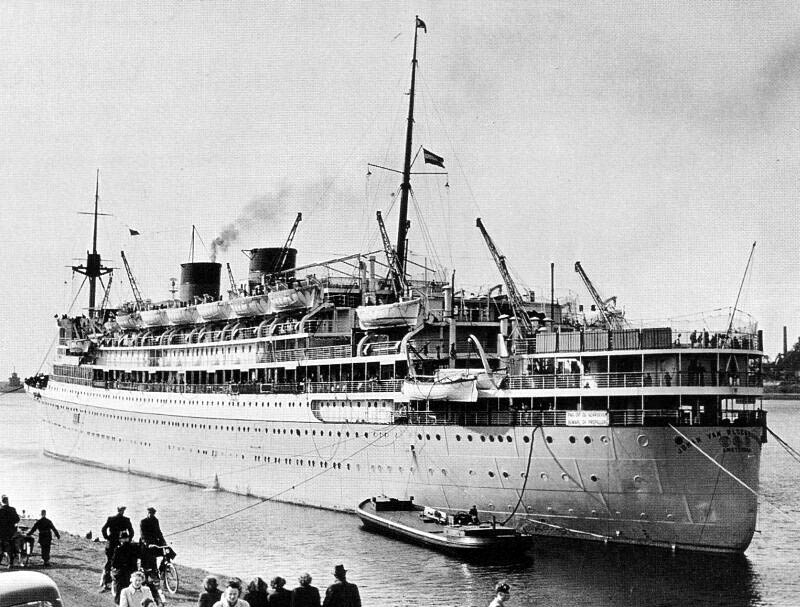
She is seen
departing Amsterdam in 1947 – note the life rafts along the
aft deck
After her much-needed overhaul the Johan van
Oldenbarnevelt returned to her what seemed like her old Amsterdam
to the Dutch East Indies service. She departed Amsterdam on her
first voyage on June 15, 1946, bound for the Dutch East Indies
where she arrived in. She departed full of Dutch soldiers all of
whom disembarked in the Dutch East Indies, but for her return
voyage took on board 1,980 repatriates and arrived back in Amsterdam
on August 23. Many of the repatriates were ill and required
medical assistance onboard, but upon arrival in Amsterdam some
were taken to hospital. Illnesses had occurred mostly due to the
situation having deteriorated in Indonesia due the violent
actions by protesting Indonesians fighting for independence that
had turned so ugly, especially for the locals!
On her first voyage as shown above, whish is
officially listed as Voyage number 1; She was under the command
of Captain J. B. Roeterink and departed Amsterdam on 16 June,
1946 sailing via Southampton June 17 to 19, Port Said June 28, Suez
July 1, Batavia July 17 to 25. Return voyage via Suez, Port Said,
arrive back in Amsterdam August 23.
Obviously that passenger numbers to that region
were close to non-existent due the ongoing violence there, thus
the JVO would be used mostly during this third period of her life
to carry Dutch troops, both there and some back home, as well as
countless Dutch families that had lived there be they of
Indonesian origin or of Dutch origins, for according to the
Dutch, they are all treated as Dutch equals.
She made two further voyages and after Voyage 3
she returned to Amsterdam on April 6, 1947. Once she had unloaded
all her passengers, she headed for the NDSM shipyards where a
little work was undertaken, but moreso a good paintjob was
urgently required, for she still looked like that war ship all risty
and with paint falling off her! When completed, she looked like a
brand new ship in her company colours, a gleaming white
superstructure and the standard grey gull with red boot topping
(below water and just above meeting the grey hull line).
*******************************
Pieter
Willem Goldhoorn sails on the
Johan
van Oldenbarnevelt to the Netherlands East Indies
But now we come to and exciting part of our
story and this relates to JVO’s Voyage number 4. It is in
regard a Dutch soldier who sailed on her in May 1947 from
Amsterdam to Indonesia and I am sure that you will find this more
personal story interesting, but his personal photographs, besides
being rare provide a picture of those days of life at sea, etc.
They were provided to the author by his son.
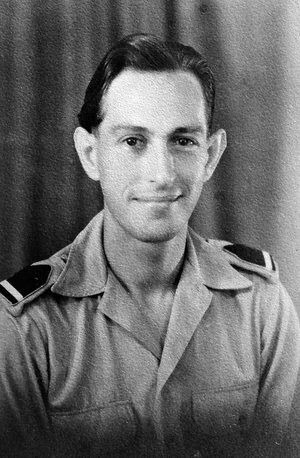
A
photograph of the late Pieter Willem Goldhoorn whilst in service
in Indonesia
Photograph provided
by & © Harry Goldhoorn
Some time back I
received a most welcome email from Mr. Harry Goldhoorn who
wrote:
“My dad departed Amsterdam on May 8, 1947
for the Dutch East Indies on the much loved liner the Johan van
Oldenbarnevelt for the “Royal Netherlands East Indies
Army” or the “KNIL” operations. Your website gave
some interesting information regarding the departure of the ship
from the Java wharf in Amsterdam. That was a piece of information
I could not find in my Father’s photo album, but I
discovered it via your website. My Father’s name was Pieter
Willem Goldhoorn who sadly passed away on April 11, 2008.
Recently I have been busy digitizing and publishing his old
photo’s which he made during his voyage. You are welcome to
use these on the Johan van Oldenbarnevelt page.”
For interest, “KNIL” stands
for “Koninklijk Nederlands Indisch Leger” or the
“Royal Netherlands East Indies Army” that was a
section of the Army that operated the former colony of the
Netherlands East Indies (also known as the Dutch East Indies)
that later became known as Indonesia.
I am most grateful to Mr. Harry Goldhoorn for
writing and providing these wonderful photographs and I trust
that this short story with the accompanying photographs will do
both Harry and his late Father, Mr. Pieter Willem Goldhoorn
justice!
Reuben Goossens.
Voyage number 4:
m.s. Johan van Oldenbarnevelt had returned to
the Java Kade having been freshly painted and all cleaned up and
she looked simply perfect ready for her next voyage. She looked
spic and span, just like a full fledged First Class deluxe Liner
should look like, but, she was far from being just that, for she
may have looked it externally, but internally she was still just
a troopship!
For this next voyage number 4, it was more than
obvious for there was not one person who was about to sail on her
that arrived shipside in a limo, a luxury car or were chauffeur
driven, but instead they came in a stream of troop lorries, or an
officer arriving in a jeep!
Prior to boarding, there was ample time for
soldiers to go and pose at the ships bow for a quick photograph,
for let’s face it, this was going to be quite an adventure,
for most had never been on a long ocean voyage on one of the
countries famed liners in their lives and may not go on another
ever again, well they would have to come homewards on a ship, but
many would came home in much less finer conditions than that of
the JVO, for there were many Victory ships in operations and
their condition were known to be woeful and worse still the
terrible food that was served, at least on the JVO the food was
of a very high standard, which was something that had so often
been written about!
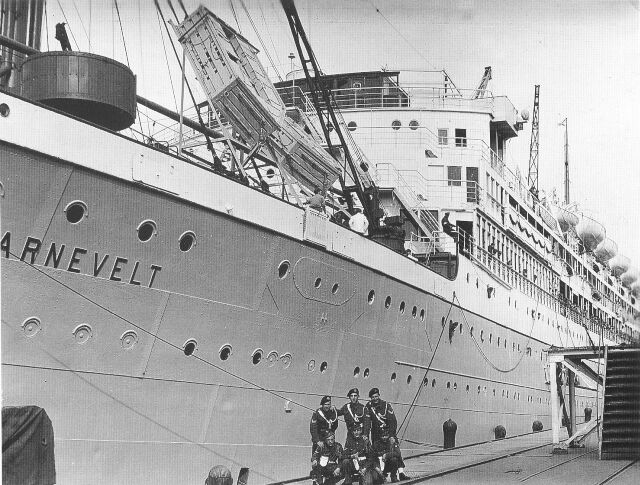
JVO is seen
here on the Java Kade on May 8, 1947 ready for departure
Notes:
The forward gun pits were no longer in use, and they were removed
in 1948
Whereas the
life raft containers were removed in 1949, it was a work in
progress
From the
author’s collection
Soldier Pieter Goldhoorn boarded the JVO with
all of his colleagues and soon made himself familiar with the
ship that he would be home for the next few weeks, then as
departure approached almost everyone made for the outer decks for
the military band was ashore and had commenced to play some
stirring music as the ship was about to sail. Then came the time
that Captain G. A. Mann slowly moved the ship from the Java Kade
into the River and head her towards the Locks at Ijmuiden and the
open Sea on May 8, 1947.
The JVO sailed directly for Port Said arriving
on May 18 and the next day she was at Suez. She then headed for
the East Indies and arrived at the first port being Sabang on
June 1, Belawan the next day, Palembang June 3 and she then
headed to Batavia (Jakarta, I assume at the port of Tandjung Priok)
arriving on June 5. She also visited Surabaya and Semarang (no
dates available) and returned to Batavia (Jakarta) and departed
from there on June 11 going homeward.
Obviously, soldiers disembarked at various
ports, between Sabang and Batavia. Also on board there was one of
the Royal Military Music Corps and they disembarked at Sabang.
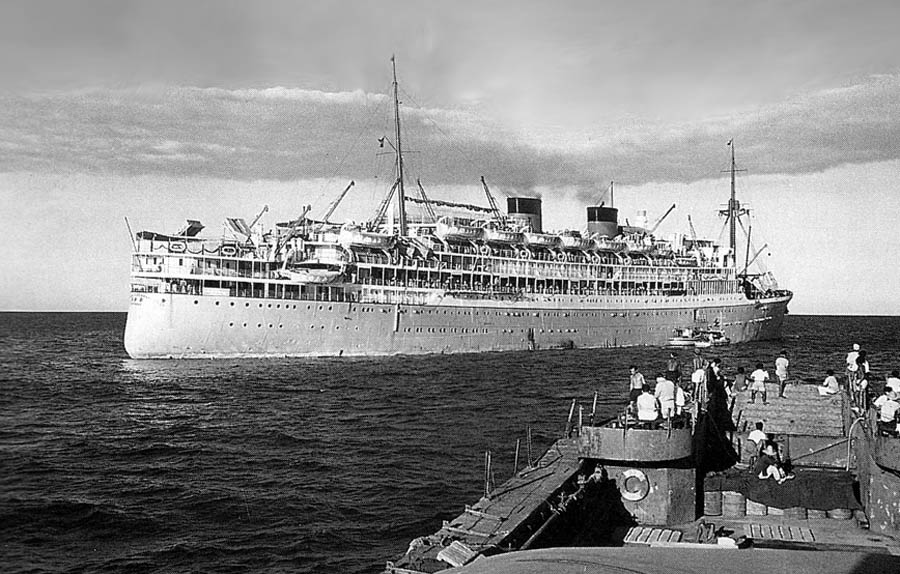
The JVO
seen at Belawan on June 2, 1947 bound for Batavia (Jakarta)
Her return voyage departed Batavia in Indonesia
on June 12, as she headed first for Singapore arriving on June
16, next came Colombo (Ceylon) June 21, through the Suez Canal
July 1, Port Said the next day and the JVO sailed directly to her
home port arriving in Amsterdam on July 12, 1947.
Mr.
Goldhoorn’s Photo Album
With
captions by his son, Harry Goldhoorn
Please
Note: All photographs on this page, except for those marked
otherwise, were taken by Mr. Pieter Willem Goldhoorn and are
under Copyright © protection by Mr. Harry Goldhoorn. These
photographs MUST NOT BE COPIED BY ANY MEDIA without
prior permission requested from the owner. See email
ssMaritime details at the bottom of this page.
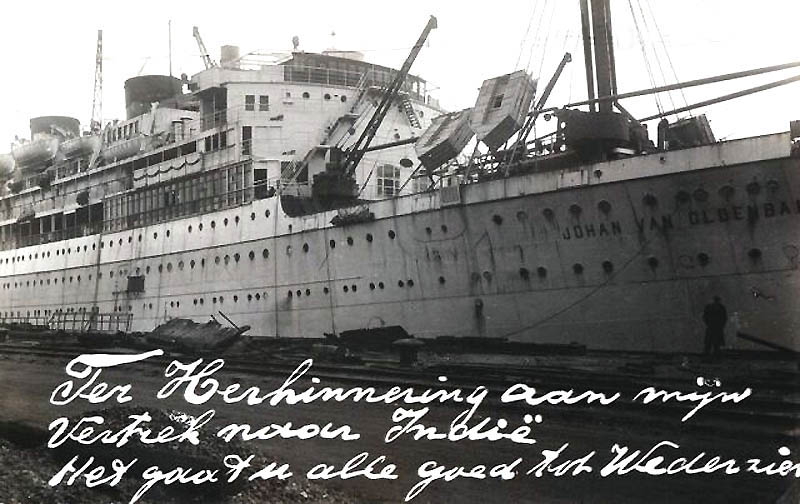
A photo of
the ship with a note by my Father ….
“As a
memory to my departure to East India (Indonesia) – “
Note:
This photo is from an earlier departure as that is obvious from
her paintwork – The author
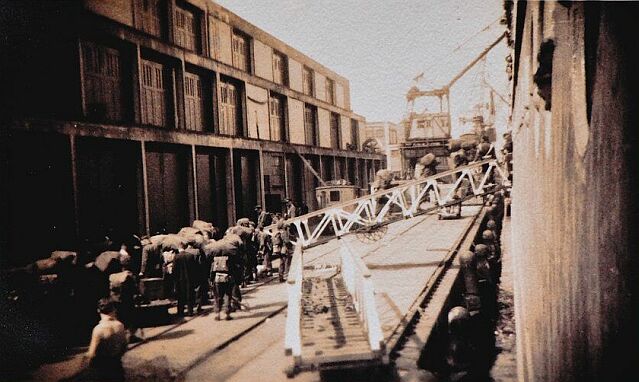
Above
and below: Boarding time of the Dutch soldiers in Amsterdam
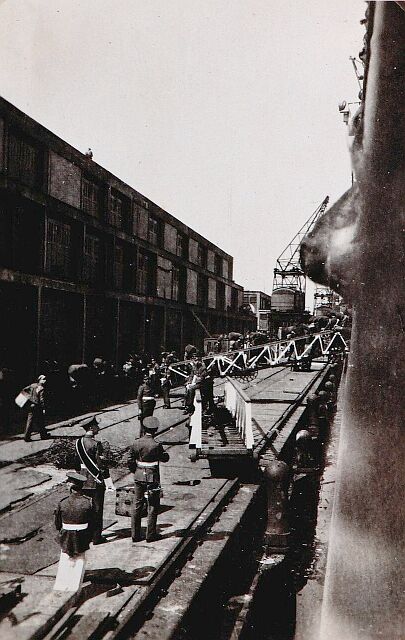
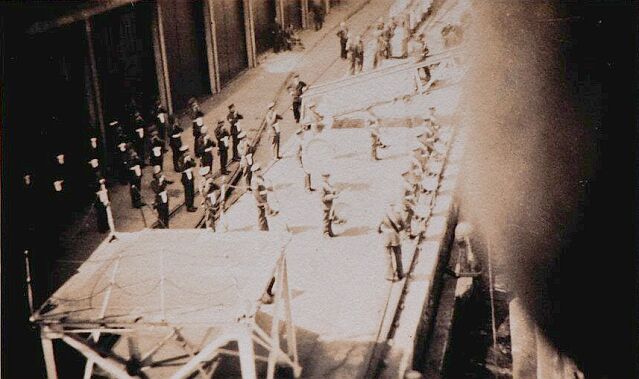
Just as the
Johan was ready to depart the military band was there to play
some rousing departure music
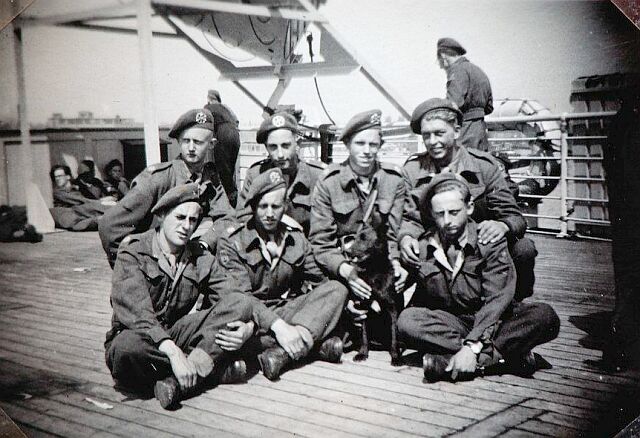
Friends on
deck: Names Top left & Clockwise: Dopma, Goldhoorn, Beunk, Reitsema,
Spaans, Beusink & ?
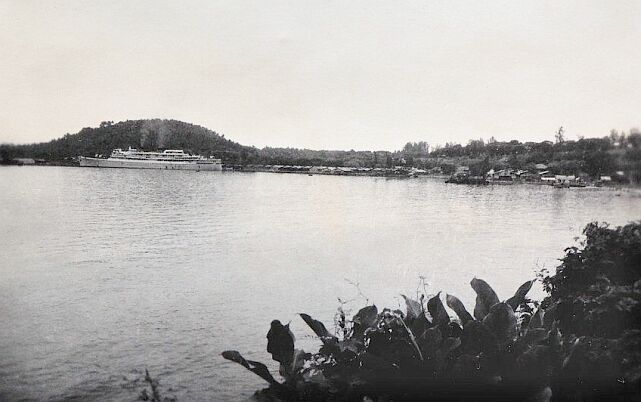
Above
& below: m.s. Johan van Oldenbarnevelt seen at Sabang on
June 1, 1947, Java Island, Indonesia
Today the
region is known as is known as Aceh
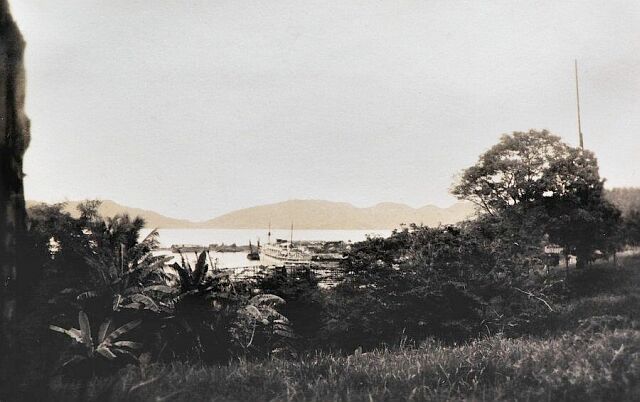
Coming
Home by Ship
“My Father’s return voyage was on
April 1, 1950 when he departed Tandjong Priok (the port of Jakarta)
on the American ship, the U.S.S. General C.H. Muir (AP-142).
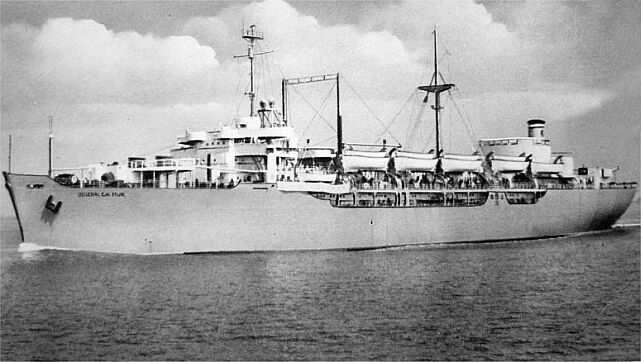
USS General
C.H. Muir seen in 1950
From the
author’s collection
“She passed Jebel and Falcon Islands on
April 17, and made a short call at the port of Suez at the
entrance of the Canal. She then sailed through the Suez Canal on
the 18th. The last port of call was Motril Spain (close to the
mountains of Sierra Nevada) on April 20 and she arrived in the Netherlands
on the 24th.bringing my Father home from his duties abroad.”
*******************************
From the previous voyage, number 4, the JVO
continued sailing to Indonesia for another eight voyages, up to
and including voyage 12, that had just the military on board to Indonesia
and homeward she had repatriates as well as soldiers who had
completed their service there. The Johan van Oldenbarnevelt
arrived back in Amsterdam on September 1, 1949 and her days would
slowly begin to change back to what used to be normal, well
almost!
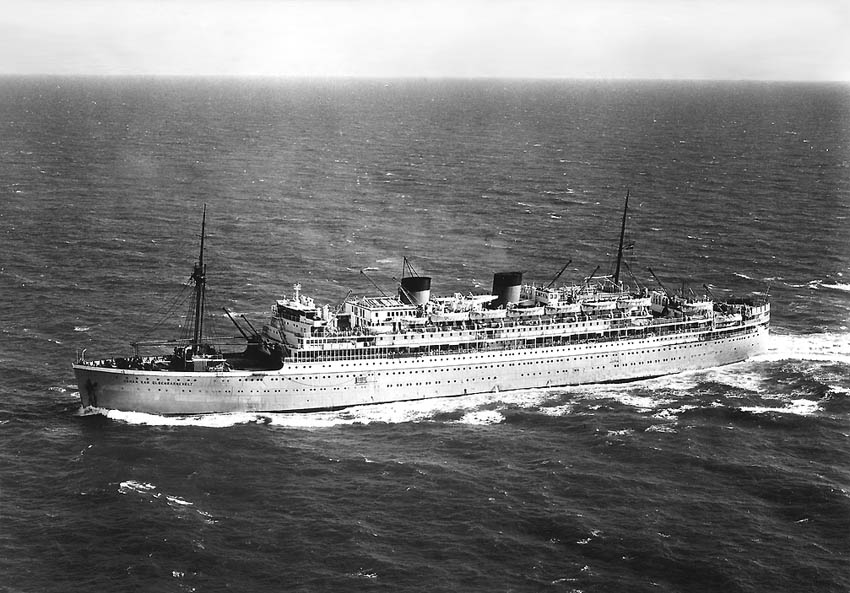
The JVO
seen at full speed ahead at sea during one of her latter troop
sailings
Finally
Back to Passenger Services!
Voyage number 13 was JVO’s lucky number,
for it became the very first voyage since the commencement of the
war that she would carry actual passengers, in fact there would
be a special passenger train put on to bring then to Amsterdam
which pulled up, and some 540 were ready to board the spruced up
JVO for their voyage to the East Indies, that now seemed to have
settled down. She was certainly not a full ship, but she was a
passenger ship for the very first time and they would have a
wonderful time as they all travelled First Class.
The Johan departed Amsterdam under the command
of Captain H. A. Broere on October 1, and she sailed to Lisbon
October 6, Gibraltar the next day, Port Said October 12, Suez the
next day, Sabang October 25, Belawan the next day, Batavia
October 29, Semarang October 31, Surabaya November 9 to 11, Batavia
November 11.
With her passengers having disembarked at
various ports and in Indonesia, for the return voyage she was
once again packed to the brim with returning soldiers and
repatriates. Departing Batavia November 11, Suez November 25, Port
Said November 27, Gibraltar December 2, and she arrived home in Amsterdam
on December 6, her first partial passenger voyage was over!
However, this continued for the next two voyages, number 14 and
15.
But in the mid 1950s the political climate in
Indonesia had changed so much that the Johan van Oldenbarnevelt
was required on new and more lucrative services, although she
would still return on various occasions to Indonesia during the
50’s to carry thousands of Dutch citizens back to the
Netherlands from there due to the ongoing situation as well as
countless Indonesians preferred the better lifestyle that was
available to them in Holland, and they knew that they were
treated as equals! Thus she began to operate a migrant service,
first one to South Africa and then to Australia.
Voyage number 16 was again under the command of
Captain Broere and she would sail in a one class configuration as
she was packed with German and Dutch immigrants bound for South
Africa. She departed Amsterdam on June 7, 1950 sailing via Las
Palmas, Walvis Bay, to Cape Town 25 to 27 June. When all her
passengers had disembarked, she departed on June 27 and headed
for Indo nesia where she called on Surabaya, Semarang and arrived
at Jakarta on 20 July where she took on board repatriates and
Dutch servicemen ready to come home. She departed Jakarta on July
21 and sailed via Suez, Port Said directly to Amsterdam arriving
on August 8.
Australia
Bound!
Voyage number 17 was very special indeed
for it meant that the JVO would finally return to Australia and
this would be a voyage that would make her a popular a regular
visitor to Australia for the next twelve and a half years.
Although she had visited both Australia previously, but only as a
Troop Ship, but this time she would arrive as a genuine passenger
liner filled with migrants!
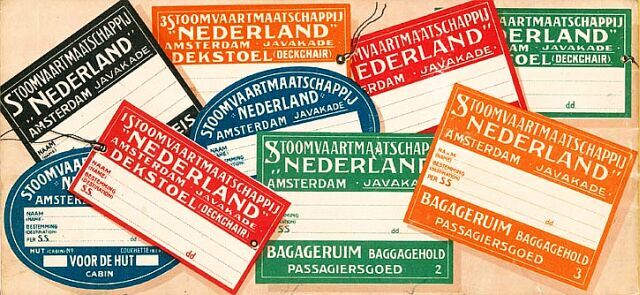
Here we see
the days when labels were still the norm!
The wharf was filled with excitement as her
passengers were checking in and awaiting to board the JVO, as
they did and were shown to their cabins, they settled in and soon
began to explore this fine ship and all her beautiful lounges,
and finally they ventured out on deck as the ship was ready to
depart, and the was band playing shore side.
It was September 6, 1950, as the Johan van
Oldenbarnevelt departed Amsterdam for this exciting voyage from
the Netherlands to Australia. She made a rapid voyage to Port
Said arriving on September 15, the transiting the Suez Canal the
next day with a very brief stop at Suez that day and continued to
Aden arriving on September 19.
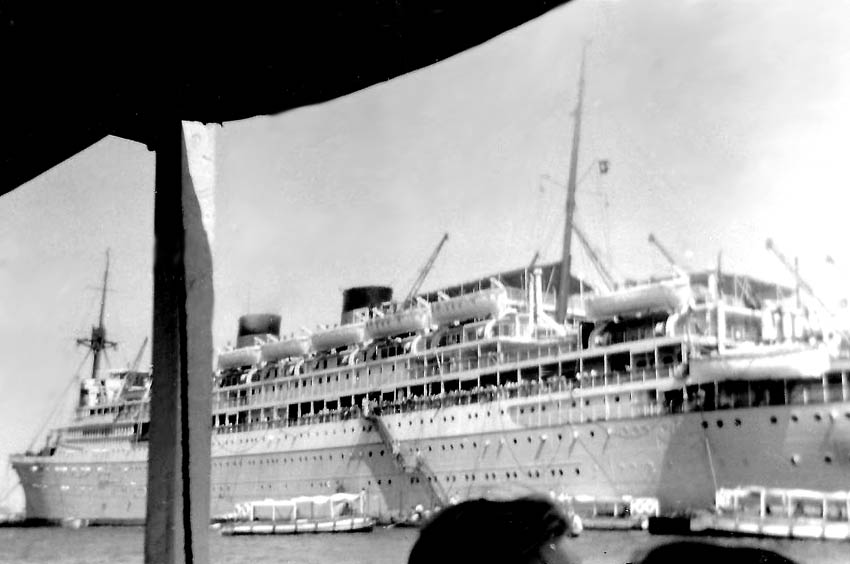
She is seen
at anchor at Aden bound for Australia
From Aden it was south across the Indian Ocean
direct to Western Australia to the port city of Fremantle close
to the city of Perth, arriving on October 2. She departed the
next day and from there she sailed around the bottom of Australia
and the Great Southern Sea, being a part of the ocean that can
often be extremely rough indeed! She headed east and arrived in Melbourne
Victoria on October 9, and departing the next day for her last
Australian leg northward to Australia’s largest city, Sydney
where she arrived on October 14, 1950.
However, upon arrival it turned out there were
quite a few liners in that day, thus the JVO, like all ships
having to receive clearance, thus she had to wait at anchor in
Sydney Harbour and await her turn! As soon she was cleared she
was permitted to head for her allotted berth.
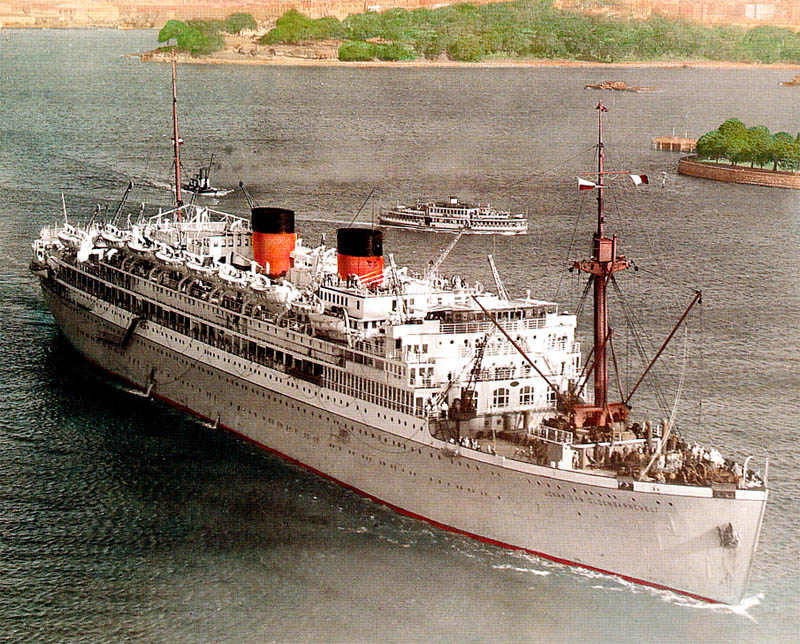
The JVO is
seen heading for her Sydney berth on October 14, 1950
Once she had offloaded all the migrants in Australia
she departed Sydney on October 14, and headed northward for Indonesia,
where she would pick up further service men as well as civilians
who would come to the Netherlands to make their home there. Her
first port of call was Makassar arriving on October 23, Jakarta
October 30, Belawan November 2, and Sabang the next day. The JVO
then heaved via Colombo, Aden, the Suez Canal, Port Said direct
to Amsterdam arriving on November 25.
It is interesting to note that one of the Three
Dutch “Victory” Ships the SS Waterman joined the JVO in
convoy on November 30 in Jakarta and sailed with her all the way
home to Amsterdam!
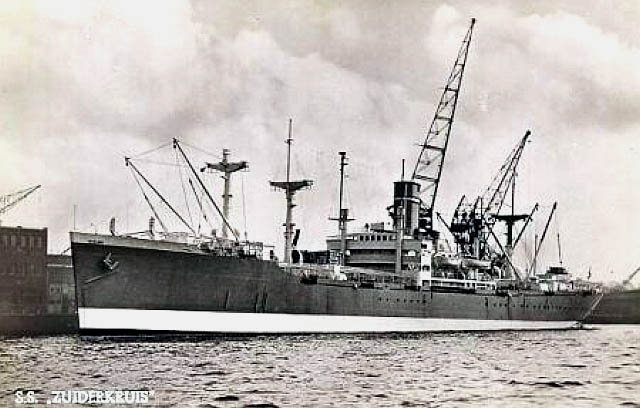
SS
Zuiderkruis an identical sister to the SS Waterman
These were
radically rebuilt later into much improved migrant ships
Her next two voyages numbers 18 and 19 were
much of the same visiting Fremantle, Melbourne and Sydney
Australia and then up to Indonesia to collect more soldiers and
repatriates, etc and transports then to Holland in comfort!
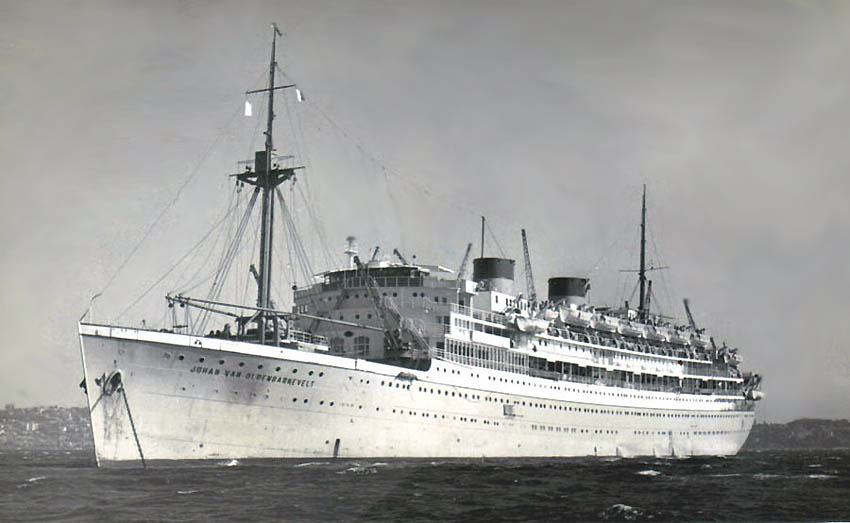
The JVO is
at Anchor in Sydney harbour awaiting clearance in May 1951
This was
Voyage number 19 being her last visit in this guise
But the time had come that the JVO was in need
of a genuine refit and make her a true and a full scale passenger
liner as she was prior to the war, for to date she was still just
the most basic migrant ship as well as a troop and a repatriates
transport ship.
Finally in July 1952 the Johan van
Oldenbarnevelt was withdrawn service and see her enter the
Amsterdam Dry-dock where her original builders would give her an
extensive refit for her new life.
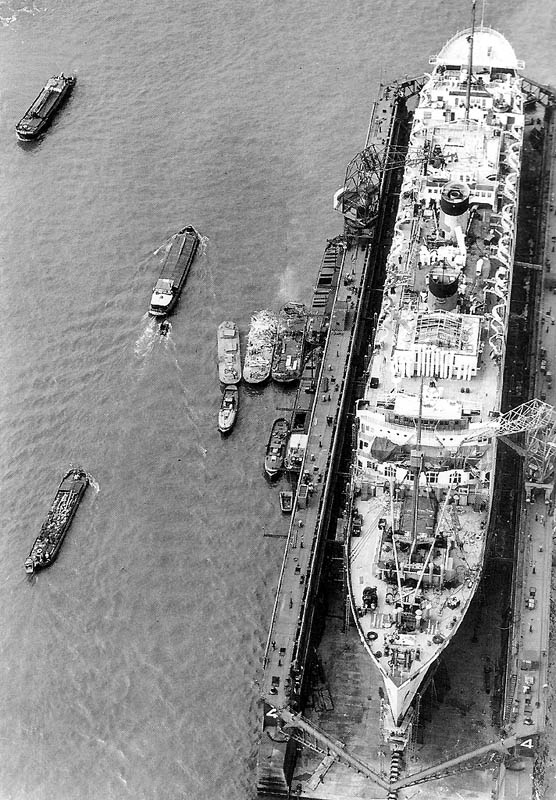
The JVO is
seen in the Prins Hendrik dry dock on August 23, 191 still
undergoing her massive refit
Required was metal work, as well as attention
to the engine room and generators, electric wiring, plumbing and
deck repairs, considering there were still signs of war damage.
Apart from all that, there was so much internal work and we have
not even looked at the passenger side as yet, for that would be
most extensive. All cabins would be completely refurbished with
brand new closets; furnishings, bedding, floors covering, wash
basins and taps. Also the ship was being fitted with a very
efficient forced air ventilation cooling system. Many of the
large dormitories were converted into cabins and became brand new
4, 6 and 8 berth cabins. Her lounges were beautifully restored as
was the furnishings with as much of the original retained as
possible, but not all was possible, and some new had to be
obtained, but it was kept as much as possible in keeping with the
style of the ship, but also it had to be functional. Her original
First Class Loungers, except for some changes in furnishings,
looked as grand as they did before and very few actual changes
were made.
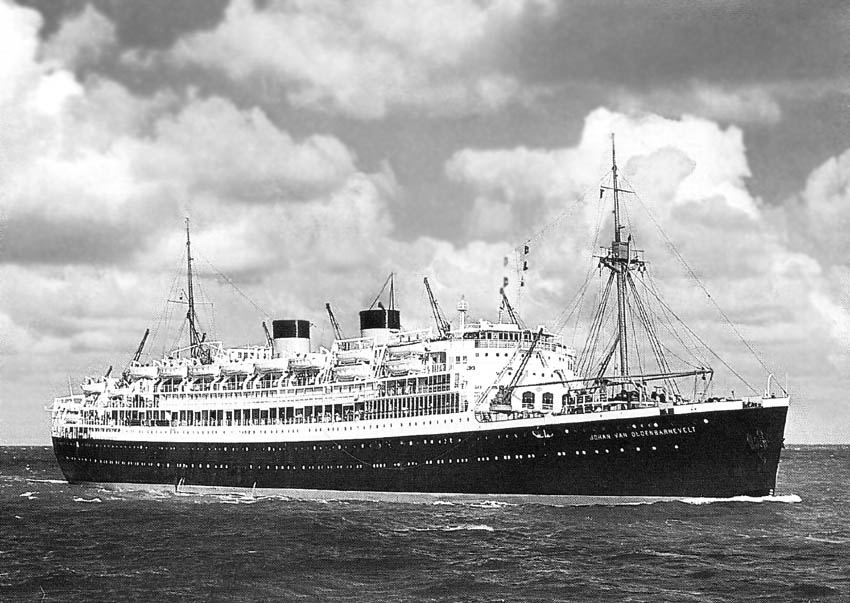
A fine new
looking JVO appeared in January 1952
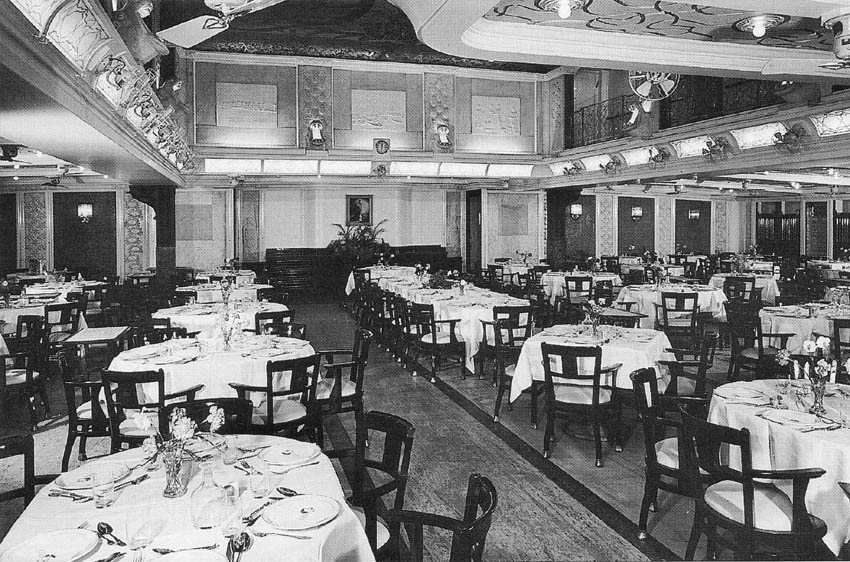
The
refurbished forward dining Room, previously being the First Class
restaurant
However, the former Second Class Smoking Room
that had that beautiful glass octagon ceiling was removed prior
to the war, thus now it was already a standard ceiling and the
Music Salon were now collectively renamed as the Palissander
Lounge, even though there was separation between these two rooms,
but it had been opened up, and now it was only the stairwell that
remained in the centre.
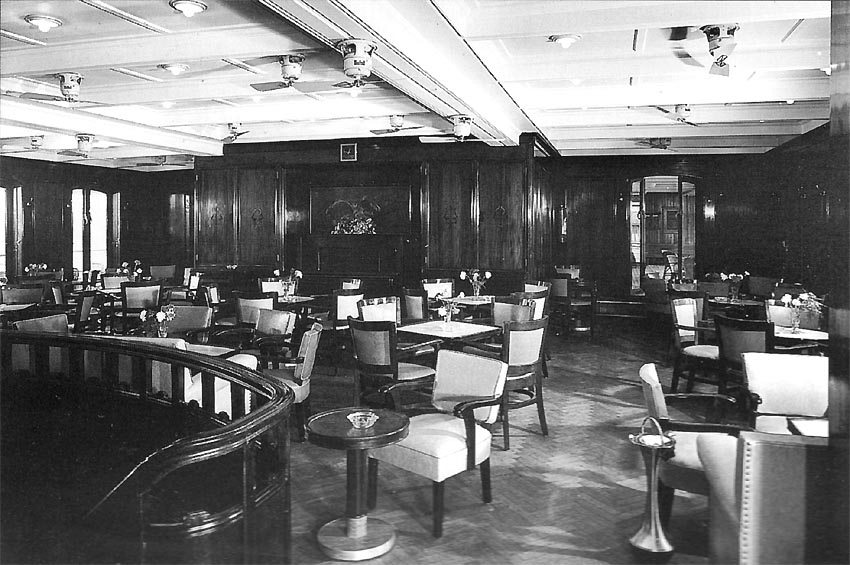
The ex
Tourist Class Smoking Room, now the Palissander Lounge
Additional eight double-banked lifeboats were
added on the fore part of boat deck. Now at 19,787 GRT she
accommodated 1,414 passengers in a one-class configuration. Her
lounges were restored to their original state with laundries and
iron rooms added to her passenger facilities.
As the standard of cabins on Johan van
Oldenbarnevelt was not that of her running mate, being the newer
Oranje (famed for serving as a hospital ship for the Australian
Navy during the war), her fares were also slightly less, but food
and service remained of the same high standard that the
Netherland Line was so famed for. Trails were run on the 8th and
9th of January 1952.
She departed Amsterdam for Australia on
Wednesday 23 January 1952, being a voyage with a troublesome
start as a series of fires were discovered on board. The first
being whilst she was berthed in Antwerp with another just off the
Isle of Wight. She returned to Amsterdam where a further two
fires were extinguished. Obviously, arson was suspected, and when
she finally departed again, she carried a number of Dutch
Maritime police, but, no further incidents occurred and no
arrests were ever made.
Go
to Chapter 4 - A New
Lease of Life
Or
the - JVO Index
***************************
“Blue Water Liners sailing to
the distant shores.
I watched them come, I watched them go and I watched them
die.”
ENTER
OUR … ssMaritime Main
INDEX
Where
you will discover well over 1,365 Classic Passenger &
Passenger-Cargo Liners!
The Author
has been in Passenger Shipping & the Cruise Industry for over
60 years!
For interest: Sadly an email
service to ssMaritime is no longer available, due to the
author’s old age and chronic illness as well as being
disabled, etc. In the past ssMaritime received well over 140
emails per day, but Mr. Goossens can no longer handle same. He
sincerely regrets this!
ssMaritime.com
& ssMaritime.net
Where
the ships of the past make history & the story of the 1914
built MV Doulos
Please Note: ssmaritime and associated
sites are 100% non-commercial and the author does not seek
funding or favours and never have and never will.
Photographs on ssmaritime and associate pages
are either by the author or from the author’s private
collection. In addition there are some images and photographs
that have been provided by Shipping Companies or private
photographers or collectors. Credit is given to all contributors,
however, there are some photographs provided to me without
details regarding the photographer or owner concerned.
ssMaritime
is owned & © Copyright by Reuben Goossens - All Rights
Reserved























